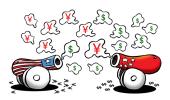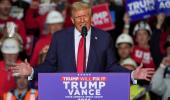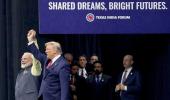'While criticising India's high tariffs, Mr Trump stated he would impose reciprocal taxes on Indian products if re-elected.'
'However, since India's tariffs follow WTO rules, Mr Trump's actions would violate these rules,' Ajay Srivastava points out.

On October 11, during a public meeting in Detroit, Donald J Trump called India the 'biggest charger' of tariffs on foreign goods.
This wasn't his first criticism. In September, he called India 'an abuser' of import tariffs, and in 2020, he labelled the country 'Tariff King'.
Let's look at whether Mr Trump's claims about India's high tariffs are accurate, whether India's tariffs break global trade rules, and how this affects the India-US relationship.
Trump focuses on the highest tariffs
India's average import tariff is 17 per cent, higher than the US' 3.3 per cent, but Mr Trump doesn't focus on this.
Instead, he highlights the highest tariffs, which grab public attention. For instance, in 2019, he pointed out India's 150 per cent tariff on US whiskey.
While India does impose high tariffs on products like whiskey (150 per cent) and automobiles (100 to 125 per cent), many countries use high tariffs to protect specific industries, so India is not alone in this practice.
Here are the highest tariffs imposed by the US on various product groups
Dairy products (188 per cent), fruit and vegetables (132 per cent), cereals and food preparations (193 per cent), oilseeds, fats, and oils (164 per cent), beverages and tobacco (150 per cent), minerals and metals (187 per cent), Clothing (135 per cent).
Mr Trump's claim that India is the Tariff King based on a few of its highest tariffs doesn't hold up when many other countries' highest tariffs are higher than India's.
Japan's highest tariff is 457 per cent, South Korea's is 887 per cent, and the US' is 350 per cent, compared to India's is 150 per cent.
The highest tariffs are often applied to protect sensitive sectors. For instance, Japan imposes high tariffs on rice to safeguard its farmers.
However, these highest tariffs are exceptions and do not represent the rates at which most trade occurs. The average tariff provides a clearer picture of a country's import duties.
India's average tariff is 17 per cent higher than the US' at 3.3 per cent, but similar to countries like South Korea (13.4 per cent) and China (7.5 per cent).
India's average tariff for industrial products is lower at 13.5 per cent, with a trade-weighted average of 9 per cent.
India does not violate WTO tariff rules, US does
The World Trade Organization (WTO) sets rules for global trade. Member countries can ask the WTO to intervene if these rules are broken.
Although the US often raises concerns about India, it hasn't challenged India's high tariffs at the WTO.
This is because the US knows India's tariffs are within the WTO's agreed-upon limits.
When the WTO started in 1995, countries set maximum tariffs on products, called 'bound tariffs', which they agreed not to exceed.
Developed countries like the US and Japan set low bound tariffs (around 3 to 4 per cent), while developing countries like India were allowed higher tariffs (40 to 150 per cent).
Developed countries allowed this flexibility in exchange for developing countries agreeing to include issues like intellectual property rights and services in WTO discussions. Because of these low-bound tariffs, the US cannot raise tariffs without breaking WTO rules.
In contrast, India can raise tariffs on steel from 10 per cent to 20 per cent without violating WTO rules since its bound tariff on steel is 40 per cent.
The gap between a country's bound and actual tariff is called 'water'. Countries like the US, Japan, and China have low 'water', while India has high 'water', meaning India has more flexibility to raise tariffs without breaking WTO rules.
The US must rely on the national security exception rules of the WTO to raise tariffs, but it is hard to argue that importing steel and aluminium threatens US national security.

Reluctance on the FTA
While criticising India's high tariffs, Mr Trump stated he would impose reciprocal taxes on Indian products if re-elected. However, since India's tariffs follow WTO rules, Mr Trump's actions would violate these rules.
The US could gain better access to the Indian market through a Free-Trade Agreement (FTA), as India has already lowered tariffs for FTA partners like ASEAN, Japan, and South Korea, showing its openness to trade. However, in an FTA, tariff cuts must be by both sides, and the US is reluctant to lower its tariffs to protect domestic industries.
This hesitation is evident in the Indo-Pacific Economic Framework (IPEF) agreement, which does not include tariff reductions.
The IPEF, involving 14 countries, including the US and India, aims to enhance cooperation in four areas: Trade, supply chain resilience, a clean economy, and a fair economy (tax and anti-corruption).
India-US relationship
Mr Trump's repeated uttering on India's high tariffs may grab headlines, but it hasn't affected the strong India-US relationship.
The US is India's top trading partner, with trade continuing to grow. Bilateral trade rose from $141.5 billion in 2018 to $190.1 billion in 2023, an increase of 34.4 per cent.
Merchandise trade jumped 41.6 per cent, and services trade grew by 22.4 per cent. India's exports to the US surged by 54.4 per cent, while US exports to India grew by 20.8 per cent.
The US-India partnership aims to maintain stability in the Indo-Pacific region and enhance defence ties through initiatives like the Quad Alliance and the US-India Defence Technology and Trade Initiative.
The Quad, comprising the US, India, Japan, and Australia, aims to strengthen supply chains while reducing dependence on China.
India-US collaboration on semiconductors and clean energy helps India pursue its tech and renewable energy goals.
Cooperation on cybersecurity and space strengthens India's digital security and space leadership, boosting innovation and scientific progress.
However, the US sometimes prioritises business interests over policy. For example, it opposed India's plan to restrict laptop imports, as this would affect American companies like Apple, Dell, and HP, which manufacture laptops in China.
With China controlling 81 per cent of the global PC and laptop market, India is working to reduce its reliance by boosting local production.
The US also imposes tariffs on Chinese products like semiconductors and solar cells to protect its industries.
This underscores India's need to follow its own strategic priorities without yielding to external pressure.
While his claims that India is a 'tariff abuser' are inaccurate, India should still consider reforming tariffs at the product level to better support national goals like promoting low-cost, value-added manufacturing and trade.
Disclaimer: These are Ajay Srivastava's personal views.
Feature Presentation: Rajesh Alva/Rediff.com











